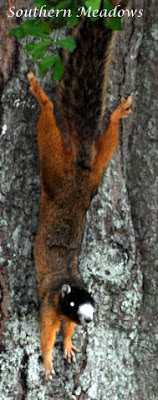Beginnings of Autumn Color, Flutterbys and Critters in Camouflage
I am struck by the beauty of Autumn. I have been patiently waiting for the changing of the colors and finally the leaves have begun to sport their bright fall colors in our woods. Each day there is more and more bold color defining the landscape.
On days when the sun shines the colors are much more striking and vibrant.
You can clearly see the chlorophyll breaking down in the leaves.
Many leaves have already fallen to the ground making a beautiful carpet in the garden. The Virginia creeper which is coming into its own as a wonderful ground cover is beginning to show its fall colors too.
The tropical fruit trees will need to be brought indoors soon but for now I am leaving them outside so the fruit can ripen. They survived the one frosty night when temperatures plummeted to 34 degrees (Fahrenheit) a week ago.
The fig tree is dropping its leaves but still bears some fruit that needs to mature. And then there is some fruit where the hornets beat me to the harvest. This is what happens when life gets too busy.
The persimmon tree didn't bear much fruit this year but a few are almost ready for picking.
With the shorter days and cooler weather there are fewer and fewer butterflies in our garden. Most of the migrating butterflies have already started on the journey south.
But there are certain butterflies that I am more apt to see in October and November. They are certainly around in spring and summer but like hiding out in the woods. Maybe because they wear the autumn colors my eye is more keen to spot them in late fall. They certainly don't sit still for long, that is why I refer to them flutterbys.
The Question Mark (can you see the mark on the center of the hindwing?) is one of the anglewing butterflies I typically see in the fall. They don't rely on blooms for food since they prefer tree sap, rotting fruit and other decaying organic matter as well as moisture from damp sand and soil. This beauty was pulling moisture from the sand in the seam of our driveway.
A closely related butterfly to the angelwings are the tortoiseshells, like this Mourning Clock, which briefly left the woodland garden for more open ground. Its velvety brown wings studded with royal blue and ochre trim are stunning if you can catch a glimpse of this butterfly with its wings open. Typically I see them perched on the side of a tree blending in well with the bark.
Other critters are camouflaging well with their fall surroundings too. This toad was hunkered down blending in with the browns of fallen leaves in the woodland garden.
And this eastern fence lizard has been enjoying the warm bricks of the house since we removed all the shrubbery.
On days when the sun shines the colors are much more striking and vibrant.
You can clearly see the chlorophyll breaking down in the leaves.
Many leaves have already fallen to the ground making a beautiful carpet in the garden. The Virginia creeper which is coming into its own as a wonderful ground cover is beginning to show its fall colors too.
The tropical fruit trees will need to be brought indoors soon but for now I am leaving them outside so the fruit can ripen. They survived the one frosty night when temperatures plummeted to 34 degrees (Fahrenheit) a week ago.
The fig tree is dropping its leaves but still bears some fruit that needs to mature. And then there is some fruit where the hornets beat me to the harvest. This is what happens when life gets too busy.
The persimmon tree didn't bear much fruit this year but a few are almost ready for picking.
With the shorter days and cooler weather there are fewer and fewer butterflies in our garden. Most of the migrating butterflies have already started on the journey south.
But there are certain butterflies that I am more apt to see in October and November. They are certainly around in spring and summer but like hiding out in the woods. Maybe because they wear the autumn colors my eye is more keen to spot them in late fall. They certainly don't sit still for long, that is why I refer to them flutterbys.
The Question Mark (can you see the mark on the center of the hindwing?) is one of the anglewing butterflies I typically see in the fall. They don't rely on blooms for food since they prefer tree sap, rotting fruit and other decaying organic matter as well as moisture from damp sand and soil. This beauty was pulling moisture from the sand in the seam of our driveway.
A closely related butterfly to the angelwings are the tortoiseshells, like this Mourning Clock, which briefly left the woodland garden for more open ground. Its velvety brown wings studded with royal blue and ochre trim are stunning if you can catch a glimpse of this butterfly with its wings open. Typically I see them perched on the side of a tree blending in well with the bark.
Other critters are camouflaging well with their fall surroundings too. This toad was hunkered down blending in with the browns of fallen leaves in the woodland garden.
And this eastern fence lizard has been enjoying the warm bricks of the house since we removed all the shrubbery.
A fallen leaf is nothing more than a Summer's wave goodbye.
I hope you too find the magic in the dawn of the cool, crisp mornings, the
the changing of the color guard, and the quietness of the landscape as it falls into its winter slumber.
the changing of the color guard, and the quietness of the landscape as it falls into its winter slumber.












.png)
